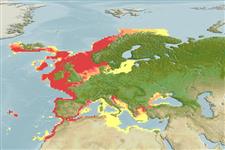Bivalvia |
Cardiida |
Cardiidae
Environment: milieu / climate zone / εύρος βάθους / distribution range
Οικολογία
; εύρος βάθους 0 - 619 m (Αναφ. 105829). Subtropical; 83°N - 27°N, 127°W - 36°E
Arctic, Eastern Atlantic and the Mediterranean Sea: from Canadian Arctic to Iceland, Norway, Sweden, south to Morocco, Madeira Island and Canary Islands, and the Mediterranean. Polar to subtropical.
Length at first maturity / Μέγεθος / Weight / Age
Γεννητική Ωρίμανση: Lm ? range ? - ? cm Max length : 7.5 cm SHL αρσενικό/απροσδιόριστο; (Αναφ. 128384)
Exists at the front (Ref. 122115). Inhabits fine sand (Ref. 106083). Common in sandy-muddy deposits (Ref. 105826). Found in an estuary (Ref. 105814) and associated with coralligenous formations (Ref. 122117). Abundant in detritic bottoms (Ref. 122133). This is a sessile-burrower suspension feeder (Ref. 96498). Feeds on phytoplankton and suspended organic material (Ref. 106986).
Life cycle and mating behavior
Γεννητική Ωρίμανση | Αναπαραγωγή | Γεννοβολία | Eggs | Γονιμότητα | Larvae
Members of the class Bivalvia are mostly gonochoric, some are protandric hermaphrodites. Life cycle: Embryos develop into free-swimming trocophore larvae, succeeded by the bivalve veliger, resembling a miniature clam.
FAO 2007 Seafood in Europe. FAO Seafood in Europe CD's 4. (Αναφ. 78075)
IUCN Red List Status
(Αναφ. 130435: Version 2025-1)
CITES status (Αναφ. 108899)
Not Evaluated
Not Evaluated
Threat to humans
Human uses
αλιεία: Εμπορικό(ά)
| FishSource |
Εργαλεία
Περισσότερες πληροφορίες
Life cycleΑναπαραγωγήΓεννητική ΩρίμανσηΓονιμότηταΓεννοβολίαEggsEgg developmentLarvae PhysiologyΚατανάλωση οξυγόνου
Human RelatedStamps, coins, misc.
Διαδικτυακές πηγές
Estimates based on models
Preferred temperature
(Ref.
115969): 6.8 - 14.2, mean 9.7 (based on 503 cells).
Fishing Vulnerability
Low vulnerability (10 of 100).
